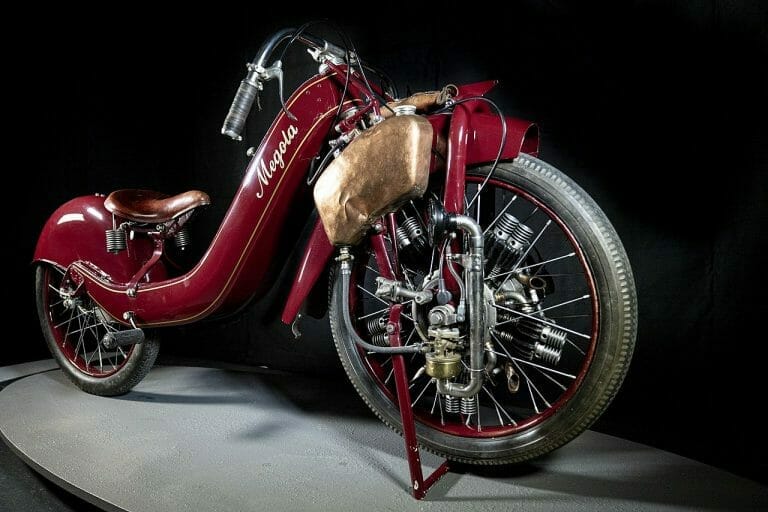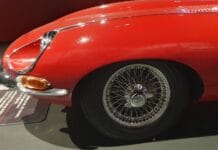Motorcycle riders know that the city is not the best place to have two-wheeled fun. Traffic lights, crosswalks, traffic jams – you need to come to a complete stop very often. However, you need to appreciate the fact that at least you’re not on a hundred-year-old Megola motorcycle, because it simply cannot stop.
Born in 1889, Friedrich Gockerell (Fritz Cockerell in patents) was a true pioneer of German motorcycle design, as well as a known name in the car and engine production. One of the temporary stops in his career was Rapp Motorenwerke, the company that later became BMW. He also developed two-stroke 8- and 4-cylinder engines, and devoted the later part of his life to the development of diesel aircraft engines as well as rotary and turbine engines.

However, this time we are more interested in another page of Gockerell’s life. In 1920, Gockerell together with Hans Meixner and Otto Landgraf founded the motorcycle manufacturer Megola. There weren’t as few motorcycle manufacturers at the time as you might imagine – in fact, the interwar period in Europe is considered the age of the motorcycle. But Megola was different from its main competitors.
Most motorcycles of that time had 1-2 cylinder engines. Meanwhile, the Megola boasted a 5-cylinder, 640cc engine. How did that work? Well, Gockerell chose a radial engine design for this machine – 5 cylinders were arranged around a central shaft. Megola prototype in the 1920s had its engine mounted directly on the rear wheel, but models from 1921 had the engine on the front wheel. Megola motorcyles were front-wheel-drive.

Megola offered two motorcycle models. The Touring Megola was designed for long comfortable journeys, had a squishy chair-like seat, rear suspension, and could reach 85 kph. Meanwhile, the Sport model was tougher and rougher, but could reach a top speed of 142 kph. Thanks to the wheel-mounted engine, Megola motorcycles had an extremely low center of gravity, were stable and handled better than one could expect. In 1924, racer Tonis Bauhofer won the German motorcycle championship on a Megola Sport motorcycle.
The Megola’s unusual engine configuration had its advantages and disadvantages. First of all, the 5-cylinder engine ran smoother than traditional 1 or 2 cylinder engines. In addition, it was not separated from the driven wheel by a clutch and a gearbox – mechanisms that normally create some power losses and inefficiencies. This solution made that 10 kW engine seem more powerful than it actually was. However, without any clutch, Megola motorcycles could not stay stationary with the engine running. A Megola motorcycle could only be started by raising the front wheel off the ground (and that is why the engine was not installed at the rear) or simply by running with it between your legs. Although these motorcycles had decent rear brakes, it was impossible to come to a complete stop with the engine running. So, when they needed to stop shortly, Megola riders would go in circles or cut their engine every time. Admittedly, it’s worth noting that traffic in the early 20th century was pretty forgiving for such strange designs.

Engine of a Megola motorcycle rotated with the wheel to cool the cylinders. These motorcycles had a kind of direct transmission – the engine was spinning 6 times faster than the wheel. In other words, a motor rotating 3600 revolutions per minute would turn the wheel 600 times. No gears though. The rotation of the engine enhanced the gyroscope effect, which stabilized the motorcycle, but made it somewhat difficult to lean into the corners. However, this made it harder to carry fuel, electricity and oil into the engine cylinders – everything had to be fed through the axle of the wheel. That is why an oil tank was mounted directly above the engine.
Megola’s motorcycle had two fuel tanks. One was elegantly hidden in a sleek motorcycle frame, which was also unusual and more like a car body in its design. The other much smaller tank was located directly above the front wheel – engine drank fuel from this tank. Fuel from the main tank had to be transferred to the feeding tank with a hand pump. Unlike many motorcycles of the time, the Megola Touring had comfortable suspension with sprung front and rear wheels. Interestingly, the inner tubes for tires had to be sausage-shaped, not donut-shaped, so they could be changed without removing the wheels. This was very important, because removing the front drive wheel of a Megola motorcycle was as difficult as you might imagine. Megola motorcycles were expensive, but fast, stable and kind of beautiful. In addition, all had tachometers, a fuel level indicator, an ammeter – conveniences that many other motorcycles lacked at the time.

In total, around 2,000 Megola motorcycles were produced in less than five years, which was actually a good production rate for the time. Megola’s were comfortable and stable, but terribly impractical. They could not stand still with the engine running, had way too many many moving and wearing parts, and every time the rider had to brake he had to fight the inertia of the engine. It is believed that only 15 of the original motorcycles survived to this day, with a few more replicas made later.




